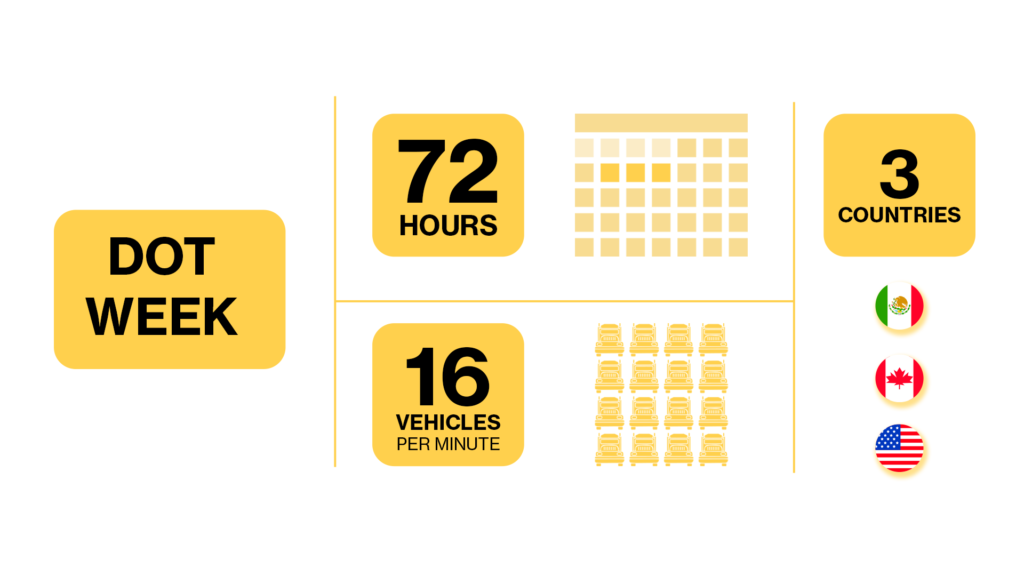Navigating DOT Week 2024: Strategic Insights for Carriers and Shippers
Dina Youssef
Table of Contents
Introduction
- Overview of DOT Week
- Importance for Shippers and Carriers
Understanding DOT Week
- What is DOT Week?
- Objectives and Historical Context
- Key Regulations and Standards Reviewed
Preparation Strategies for Carriers
- Equipment Checks and Maintenance
- Ensuring Compliance with Hours of Service
- Staff Training and Awareness
- Documentation and Record-keeping Tips
Preparation Strategies for Shippers
- Scheduling and Planning Around DOT Week
- Ensuring Carrier Compliance
- Load Planning and Weight Management
- Communication with Logistics Partners
Technological Tools and Resources
- Software for Compliance Management
- Mobile Apps for Road Safety and Compliance
- Online Resources for Regulation Updates
Common Challenges and Solutions
- Addressing Frequent Compliance Issues
- Tips for Avoiding Fines and Delays
Conclusion
- Recap of Key Points
- Encouragement for Proactive Preparation

Introduction
Preparing for DOT Week 2024: Essential Guidance for Shippers & Carriers
DOT Week, formally known as the Commercial Vehicle Safety Alliance’s (CVSA) International Roadcheck, is a significant event in the logistics and transportation industry, focusing on the safety and compliance of heavy vehicles across North America. For shippers and carriers, this period is not just a time of rigorous inspections but also an opportunity to reinforce best practices in fleet management and operations. Understanding and preparing for DOT Week is crucial in avoiding disruptions, minimizing the risk of penalties, and ensuring smooth operations throughout one of the industry’s most intensive weeks for safety checks.
The upcoming DOT Road Week for 2024 is scheduled to take place between May 14th and May 16th. Let’s delve into what DOT Week entails and why it’s a pivotal time for both carriers and shippers.
Understanding DOT Week
What is DOT Week?
DOT Week, or the International Roadcheck by the Commercial Vehicle Safety Alliance (CVSA), is an annual event that typically occurs over a 72-hour period, involving thousands of inspections on commercial vehicles across North America. During this week, enforcement officers conduct the North American Standard Level I Inspection, a 37-step procedure that includes checks on both the vehicle’s mechanical soundness and the driver’s adherence to safety regulations. This comprehensive inspection focuses on critical aspects such as brake systems, cargo securement, lighting, steering mechanisms, and hours of service compliance.
Objectives and Historical Context
The primary goal of DOT Week is to increase road safety by enforcing compliance with transportation regulations. Instituted over 30 years ago, this initiative has significantly contributed to the reduction of accidents involving heavy vehicles. DOT Week also serves an educational purpose, helping carriers and drivers understand the importance of vehicle maintenance and regulatory compliance.
Key Regulations and Standards Reviewed
During DOT Week, special attention is given to:
- Hours of Service: Ensuring drivers comply with the mandated limits on driving hours to prevent fatigue.
- Vehicle Maintenance: Checking for faults in critical components like brakes, tires, and lights.
- Cargo Securement: Verifying that all loads are adequately secured to prevent shifting or loss during transit.
These checks are crucial not only for safety but also for maintaining the reputation and operational efficiency of transportation businesses.

Preparation Strategies for Carriers
Equipment Checks and Maintenance
Preparation for DOT Week should start well in advance, with carriers rigorously inspecting their fleets. Ensure that:
- All vehicles are up to date with their maintenance schedules.
- Critical components, such as brakes and tires, are in excellent condition.
- Any previously noted defects have been addressed.
Ensuring Compliance with Hours of Service
Hours of service violations are one of the most common issues during DOT Week. Carriers should:
- Review logbooks and ensure all drivers are fully compliant with current regulations.
- Utilize electronic logging devices (ELDs) to track and manage driver hours accurately.
- Conduct refresher training sessions with drivers to emphasize the importance of compliance.
Staff Training and Awareness
Educating your team is key to smooth operations during DOT Week. Conduct training sessions that cover:
- The specifics of the North American Standard Level I Inspection.
- Best practices for maintaining logs and other necessary documentation.
- The importance of pre-trip and post-trip vehicle inspections.
Documentation and Record-Keeping Tips
Accurate and up-to-date documentation can make or break your DOT Week experience. Ensure that:
- All necessary paperwork is easily accessible, including registration, proof of insurance, and inspection reports.
- Drivers understand how to present documents during an inspection efficiently.
- Electronic records are backed up and secure.
This proactive approach helps carriers avoid fines and interruptions during DOT Week, ensuring that their operations continue smoothly even under scrutiny.
Preparation Strategies for Shippers
Scheduling and Planning around DOT Week
For shippers, the impact of DOT Week can extend beyond the carriers to their own scheduling and delivery timelines. Proactive planning is essential:
- Anticipate Delays: Understand that inspections may slow down delivery times. Plan your shipping schedule with buffer times to accommodate potential delays.
- Prioritize Loads: Schedule less time-sensitive shipments during DOT Week and prioritize urgent deliveries before or after the event.
Ensuring Carrier Compliance
Partnering with compliant carriers is crucial for shippers to avoid disruptions:
- Verify Carrier Credentials: Work only with carriers that have a good track record of compliance and safety.
- Request Compliance Reports: Before DOT Week, ask carriers for their latest inspection and compliance reports as part of your due diligence.
Load Planning and Weight Management
Proper load planning is crucial to prevent issues during inspections:
- Weight Limits: Ensure that the weight and distribution of your cargo comply with federal regulations to avoid overloading.
- Securement Techniques: Use industry-standard methods to secure cargo. Provide guidelines and resources to carriers about the best practices for cargo securement.
Communication with Logistics Partners
Effective communication can mitigate many potential problems during DOT Week:
- Regular Updates: Maintain open lines of communication with carriers. Regular updates can help manage expectations and make quick adjustments as necessary.
- Feedback System: Implement a system for carriers to provide feedback on logistical challenges during DOT Week to improve future planning.
Technological Tools and Resources
Software for Compliance Management
Leveraging technology can significantly ease the burden of compliance for both carriers and shippers:
- Compliance Software: Tools like Fleet Management Systems (FMS) can help carriers track vehicle maintenance and driver hours.
- Document Management Systems: Use digital solutions to keep all compliance-related documents organized and readily available.
Mobile Apps for Road Safety and Compliance
There are several mobile applications designed to assist drivers and carriers in maintaining compliance:
- ELD Apps: Electronic Logging Devices apps help manage drivers’ hours of service and ensure compliance with regulations.
- Safety Apps: Applications that provide real-time updates on road conditions and safety alerts can be invaluable during DOT Week.
Online Resources for Regulation Updates
Staying informed about the latest regulations is key:
- FMCSA Website: The Federal Motor Carrier Safety Administration’s site is a primary resource for up-to-date rules and regulations.
- CVSA Resources: Access materials directly from the Commercial Vehicle Safety Alliance for insights into inspection procedures and focal points.
Common Challenges and Solutions
Addressing Frequent Compliance Issues
Common issues during DOT Week often involve:
- Expired Documents: Regular checks and digital reminders can prevent outdated documents from causing fines.
- Mechanical Failures: Implement a stringent vehicle maintenance schedule that addresses potential failures before they become problematic.
Tips for Avoiding Fines and Delays
- Pre-Inspection Checks: Encourage carriers to conduct thorough pre-inspection checks to identify and resolve issues.
- Education and Training: Continual education on compliance for drivers can reduce the risk of violations significantly.
Conclusion
Preparing for DOT Week 2024 requires diligence and proactive planning from both shippers and carriers. By understanding the event, implementing thorough preparation strategies, and utilizing technological aids, businesses can navigate DOT Week with minimal disruption. Remember, the ultimate goal of this event is to enhance road safety, a benefit to us all.